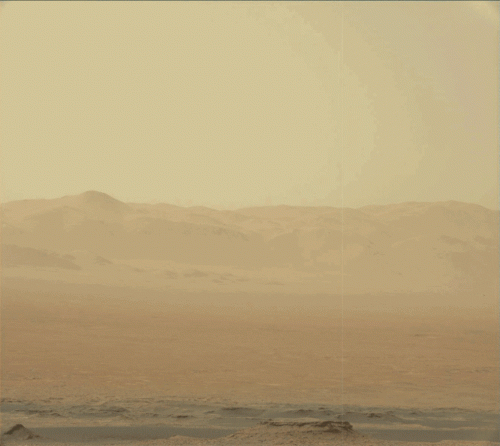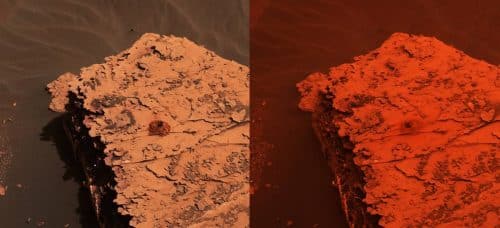A storm of tiny dust particles took over Mars during the last few weeks and caused NASA to suspend the scientific activity of the Mars Orbitonity rover, but there was no need to suspend the activity of Curiosity, which moves and explores Gale Crater - the reason is that it has an atomic power unit. Thus it can provide real-time data on the state of the storm

________________________________________
In June 2018, NASA's Mars Curiosity rover used its mast camera to capture images of the increasing haze on the surface of Mars, caused by a massive dust storm. The robotic vehicle stands inside Gale Crater and looks towards the rim of the crater. The photographs span two weeks, and start even before the storm broke out. Photo: NASA
A storm of tiny dust particles took over Mars during the last two weeks and caused the operation of the old Opterioniti Mars rover to be suspended. In contrast, NASA's Curiosity, which explores the Martian soil in Gale Crater, continues to operate without interruption. While Opportunity is powered by sunlight, and its solar panels are currently full of dust, Curiosity has a nuclear-powered battery that runs day and night.
This is a storm that covers all of Mars. Although Curiosity is on the opposite side of Mars from Opportunity, the concentration of dust in the atmosphere that blocks sunlight has doubled in the past week. The value of the figure known as "Tau" in Gale Crater reached 8 and the last time it was possible to measure - in the area where Opportunity is found, it reached level 11, and now it is no longer possible to make measurements there.
For scientists, Curiosity offers an unprecedented window to answer some questions. One of the biggest is why there are dust storms like the last one that become massive and last for months while the others stay small and localized and last at most a week?
"We don't have a good idea," said Scott Djosewicz, an atmospheric scientist at NASA's Goddard Space Flight Center in Greenbelt, Maryland, who is leading Curiosity's dust investigation.
He notes that Curiosity plus the fleet of spacecraft orbiting Mars will allow scientists for the first time to collect a wealth of dust data from both the surface and space. The last storm of global intensity to engulf Mars was in 2007, five years before Curiosity landed there.
In the animation, Curiosity heads to the rim of the crater, which is about 30 km away from where it is standing inside the crater. Daily images captured by the Mastcam show the sky becoming increasingly opaque. The thickness of the fog obscuring the sun is six to eight times thicker than normal for this period of the Martian year.

Martian dust storms are common, especially during spring and southern summer, when the planet is at its closest point to the Sun. When the atmosphere heats up, winds are created due to the contrasts in surface temperatures in different places, and transport dust particles. The carbon dioxide domes created during the winter evaporate, thicken the atmosphere and increase the air pressure. This process causes the dust clouds to rise up to a height of 60 km and more and stay there.
Despite this, dust storms on Mars are confined to the region where they formed. In contrast, the current storm, if it were to occur on Earth, is larger than the area of North America and Russia combined.
Dust storms also occur on Earth, in desert areas such as North Africa, the Middle East and the Southwest United States, but the conditions on Earth prevent them from spreading globally, said Ralph Kahn, a senior scientist at Goddard, who has studied the atmospheres of Earth and Mars. These include the structure of our thick atmosphere and the strong gravity that helps settle dust. The Earth also has a vegetation cover on the ground that binds the soil with the roots, helping to block the wind and the rain to wash the particles out of the atmosphere.
For information on the NASA website
More of the topic in Hayadan:
